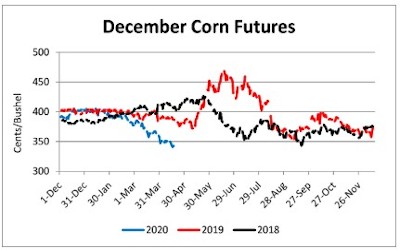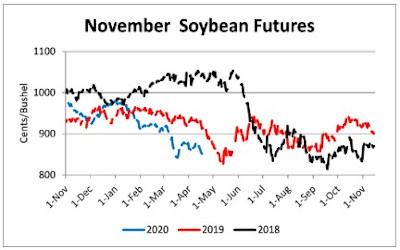Nationally the Crop Progress report estimated corn planting at 3% compared to 3% last year and a 5-year average of 4%. In Tennessee, the Crop Progress report estimated corn planted at 12% compared to 1% last week, 14% last year, and a 5-year average of 12%. In Tennessee, new crop cash corn contracts ranged from $3.16 to $3.49. December 2020 corn futures closed at $3.43, down 7 cents since last Friday. Downside price protection could be obtained by purchasing a $3.50 December 2020 Put Option costing 28 cents establishing a $3.22 futures floor.

Soybeans
Net sales reported by exporters were down compared to last week with net sales of 9.0 million bushels for the 2019/20 marketing year and 2.2 million bushels for the 2020/21 marketing year. Exports for the same period were up 45% compared to last week at 19.3 million bushels. Soybean export sales and commitments were 78% of the USDA estimated total annual exports for the 2019/20 marketing year (September 1 to August 31), compared to the previous 5-year average of 94%. Average soybean basis strengthened or remained unchanged at Memphis, Northwest Barge Points, Northwest, and Upper-middle Tennessee. Basis ranged from 10 under to 32 over the May futures contract at elevators and barge points. Average basis at the end of the week was 17 over the May futures contract. May 2020 soybean futures closed at $8.32, down 31 cents since last Friday. For the week, May 2020 soybean futures traded between $8.31 and $8.70. May/Jul and May/Nov future spreads were 10 and 19 cents. July 2020 soybean futures closed at $8.42, down 29 cents since last Friday. May soybean-to-corn price ratio was 2.58 at the end of the week.

In Tennessee, new crop soybean cash contracts ranged from $8.20 to $8.91. Nov/Dec 2020 soybean-to-corn price ratio was 2.48 at the end of the week. November 2020 soybean futures closed at $8.51, down 24 cents since last Friday. Downside price protection could be achieved by purchasing an $8.60 November 2020 Put Option which would cost 44 cents and set an $8.16 futures floor.

Cotton
Net sales reported by exporters were down compared to last week with net sales cancellations of 183,800 bales for the 2019/20 marketing year and net sales of 71,800 bales for the 2020/21 marketing year. Exports for the same time period were down 36% compared to last week at 312,000 bales. Upland cotton export sales were 109% of the USDA estimated total annual exports for the 2019/20 marketing year (August 1 to July 31), compared to the previous 5-year average of 97%. Delta upland cotton spot price quotes for April 16 were 49.04 cents/lb (41-4-34) and 51.29 cents/lb (31-3-35). Adjusted World Price (AWP) increased 0.49 cents to 44.78 cents. May 2020 cotton futures closed at 52.77 cents, down 1.6 cents since last Friday. For the week, May 2020 cotton futures traded between 51.91 and 54.55 cents. May/Jul and May/Dec cotton futures spreads were 0.09 cents and 2.49 cents. July 2020 cotton futures closed at 52.86 cents, down 1.54 cents since last Friday.

Nationally, the Crop Progress report estimated cotton planted at 9%, compared to 7% last week, 7% last year, and a 5-year average of 6%. December 2020 cotton futures closed at 55.26, down 0.7 cents since last Friday. Downside price protection could be obtained by purchasing a 56 cent December 2020 Put Option costing 5.04 cents establishing a 50.96 cent futures floor.

Wheat
Wheat net sales reported by exporters were up compared to last week with net sales of 6.6 million bushels for the 2019/20 marketing year and 15.4 million bushels for the 2020/21 marketing year. Exports for the same time period were up 90% from last week at 26.5 million bushels (a marketing year high). Wheat export sales were 94% of the USDA estimated total annual exports for the 2019/20 marketing year (June 1 to May 31), compared to the previous 5-year average of 102%. May 2020 wheat futures closed at $5.33, down 23 cents since last Friday. May 2020 wheat futures traded between $5.24 and $5.64 this week. May wheat-to-corn price ratio was 1.66. May/Jul and May/Sep future spreads were 0 and 5 cents.

Nationally the Crop Progress report estimated winter wheat condition at 62% good-to-excellent and 10% poor-to-very poor; winter wheat headed at 6% compared to 5% last year and a 5-year average of 7%; and spring wheat planted at 5% compared to 2% last year and a 5-year average of 9%. In Tennessee, winter wheat was estimated at 64% good-to-excellent and 3% poor-to-very poor; winter wheat jointing at 73% compared to 42% last week, 67% last year, and a 5-year average of 66% and winter wheat headed at 6% compared to 4% last year and a 5-year average of 5%. In Tennessee, June/July 2020 cash contracts ranged from $5.14 to $5.76. July 2020 wheat futures closed at $5.33, down 24 cents since last Friday. Downside price protection could be obtained by purchasing a $5.35 July 2020 Put Option costing 26 cents establishing a $5.09 futures floor. July wheat-to-corn price ratio was 1.62. September 2020 wheat futures closed at $5.38, down 23 cents since last Friday.

Source : tennessee.edu